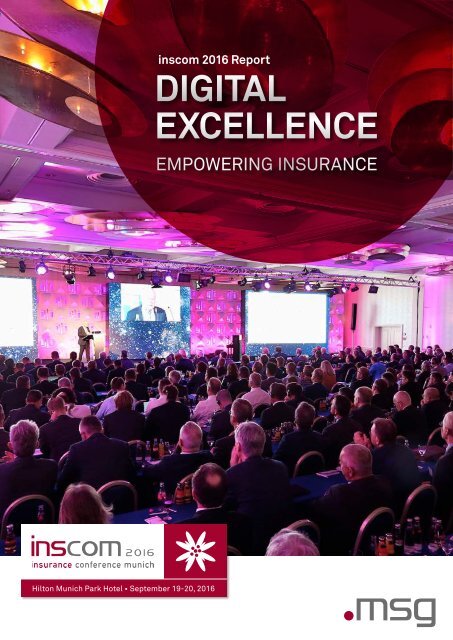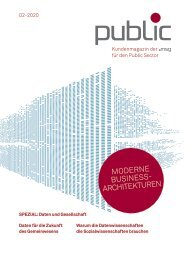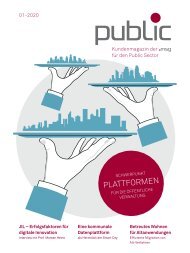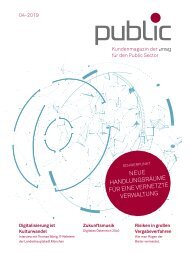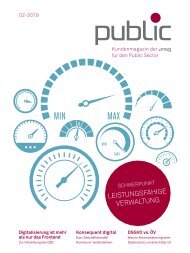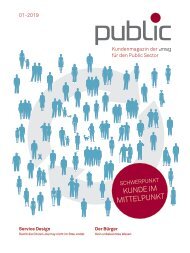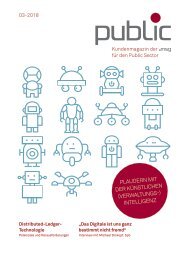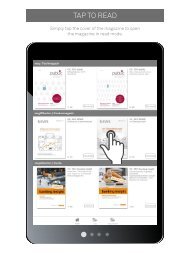EN | inscom 2016 Report
DIGITAL EXCELLENCE
DIGITAL EXCELLENCE
Create successful ePaper yourself
Turn your PDF publications into a flip-book with our unique Google optimized e-Paper software.
<strong>inscom</strong> <strong>2016</strong> <strong>Report</strong><br />
DIGITAL<br />
EXCELL<strong>EN</strong>CE<br />
EMPOWERING INSURANCE<br />
Hilton Munich Park Hotel • September 19-20, <strong>2016</strong>
Contents<br />
Digital Excellence – The Key to<br />
Success for Insurance Providers<br />
3 Foreword by Hans Zehetmaier<br />
4 Digital Excellence – Presentation by Hans Zehetmaier<br />
6 Digital Excellence – Keynote Presentations<br />
Two years ago at <strong>inscom</strong> 2014, we spoke about digital transformation<br />
as an innovation driver in the insurance sector. Today we see that<br />
the pace of digitalization in the industry has picked up enormously,<br />
powered by new technologies that help insurance providers detect<br />
potential early on and take targeted action on it. Analytics, the<br />
Internet of Things (IoT) and artificial intelligence are making the<br />
necessary technology available. What’s more, they’re on the verge<br />
of a quantum leap.<br />
10 Panel Discussion: “Insurance 2020”<br />
12 Presentations – Property and Casualty Insurance<br />
14 Presentations – Life and Health Insurance<br />
16 Presentations – SAP for Insurance<br />
18 Presentations – Innovations in the Insurance Industry<br />
22 Side Session – (RE)Insurance / Showcase msg.Insurance Suite<br />
24 Demos in the Digital Excellence Forum<br />
26 Impressions from <strong>inscom</strong> <strong>2016</strong><br />
Whether it takes the form of transformation or disruption,<br />
there is no stopping digitalization – even if it is proceeding<br />
in different directions and at different paces from<br />
one sector or insurance category to another. By integrating<br />
their clients and streamlining their digital processes,<br />
many insurers have already sustainably increased their<br />
digital efficiency.<br />
But in the face of competitive pressure from new market<br />
players that challenge the traditional business models<br />
of insurance providers, that’s not enough. Insurers that<br />
want to keep that crucial edge in the constantly changing<br />
world of digitalization need to develop new digital<br />
strategies and business models and build their digital<br />
excellence by integrating both the old and new worlds.<br />
It is crucial that they consistently focus on customers<br />
and their digital ecosystem and make their interactions<br />
with customers a positive experience. Above all, they<br />
will achieve an edge by offering innovative solutions that<br />
meet their customers’ needs and by thinking outside the<br />
conventional insurance transactions box.<br />
strategies, innovative business cases and technological<br />
developments, but also into potential risk. On behalf of<br />
msg group, I would like to extend my heartfelt thanks to<br />
you – those who participated and those who attended.<br />
It is your contributions, dedication and suggestions that<br />
have made this eighth <strong>inscom</strong> a great success. Figures<br />
also bear this out: Our industry event once again achieved<br />
a new attendance record with a total of 330 attendees<br />
from 50 insurance groups. That fills us with pride<br />
and spurs us on to continue promoting the successful<br />
process of digitalizing the industry with intelligent solutions<br />
and to once again make <strong>inscom</strong> 2018 an industry<br />
landmark.<br />
In the captivating and informative talks by top international<br />
speakers, <strong>inscom</strong> <strong>2016</strong> offered examples of just such<br />
solutions, along with insights not only into digitalization<br />
Hans Zehetmaier<br />
Chairman of the Executive Board and Co-Founder of msg systems ag<br />
3
Agenda September 19 Agenda September 20<br />
8:30<br />
Ballroom B/C<br />
Check-in<br />
9:00<br />
Ballroom B/C<br />
Summary<br />
9:30<br />
Welcome<br />
Johann Ranft, Director Marketing & Communications, msg<br />
9:15<br />
Characteristics of Digital Leadership—What Insurance CIOs Need to Know<br />
Jürgen Weiss, Managing Vice President Industry Advisory Services – Insurance, Gartner<br />
10:00<br />
10:30<br />
11:00<br />
11:45<br />
12:15<br />
12:45<br />
1:15<br />
2:15<br />
3:00<br />
Traditional Insurance Business going Digital<br />
Hans Zehetmaier, CEO, msg<br />
AXA (Deutschland) goes Digital<br />
Dr. Andrea van Aubel, Member of the Executive Board, AXA Konzern AG<br />
Coffee Break Ballroom A Salon Rumford<br />
msg News for P&C<br />
msg News for Life + Health<br />
msg News for SAP for Insurance<br />
Digital Auto Product with hybris<br />
Markus Rehle, Member of the Executive Board,<br />
HDI Versicherung AG<br />
GoSMART—Implementation of the P&C<br />
Factory at Gothaer<br />
Dr. Guido Kautz, Program Management,<br />
Gothaer Systems GmbH<br />
Jörg Rippchen, Project Management,<br />
arc innovations GmbH & Co KG<br />
Lunch Break<br />
Customer Relationship—In the Virtual<br />
World as close as in Reality<br />
Dr. Barbara Stoth, Managing Director,<br />
Braunschweig IT GmbH,<br />
Öffentliche Versicherung Braunschweig<br />
IV-PBeaKK 4.0—Implementation of a new<br />
Core System at Postbeamtenkrankenkasse<br />
Reiner Martin Ströhle,<br />
Director IT Center, Postbeamtenkrankenkasse<br />
Opportunities of Digital Processes for the<br />
Management of Life Insurance Run-off<br />
Portfolios<br />
Dr. Heinz-Peter Roß,<br />
Chief Executive Officer,<br />
Heidelberger Leben Group<br />
Striving towards the new digital normal—<br />
How UNIQA is redefining Itself<br />
Dr. Alexander Bockelmann,<br />
Chief Digital Officer and Head of Group IT,<br />
UNIQA Insurance Group<br />
Service Dominant Architecture (SDA): Core Component of Digital Transformation<br />
Prof. Dr. Markus Warg, Member of the Executive Board, SIGNAL IDUNA Group<br />
msg.PUMA: Our Journey<br />
John Connors, CIO,<br />
Liz McMahon, Facultative Business Project<br />
Leader, General Reinsurance Corporation<br />
SAP for Insurance & hybris—Key for the<br />
Digital Insurer?<br />
Tobias Berens, Head of IT,<br />
Grundeigentümer Versicherung VVaG<br />
Business Transformation based on SAP’s<br />
Next Generation Insurance Platform<br />
Dr. Uwe Hommel, Executive Vice President,<br />
Head of Digital Business Service Greater<br />
China and Head of Global Center of Expertise,<br />
SAP SE<br />
Demo<br />
Demo<br />
10:00<br />
10:45<br />
11:30<br />
12:00<br />
1:30<br />
2:00<br />
2:45<br />
3:45<br />
Coffee Break Ballroom A Salon Rumford<br />
InsurTechs—(How) are they changing the<br />
Insurance Industry?<br />
Frederik Wulff,<br />
General Representative,<br />
Markel International Deutschland<br />
Start of the Cognitive Era with Watson<br />
T echnology—Down to Earth: Specific<br />
Project at VKB<br />
Dr. Thomas Rodewis, Head of Digitalization,<br />
Versicherungskammer Bayern<br />
Mascha Minou Lentz, Associate Partner,<br />
IBM Deutschland GmbH<br />
Lunch „In the Sky“<br />
Cyber Security is Key for Digital Transformation<br />
Dr. Ralf Schneider, Group CIO, Allianz SE<br />
Panel Discussion: Insurance 2020—Digital Transformation or Digital Disruption<br />
Closing and Farewell<br />
Johann Ranft, Director Marketing & Communications, msg<br />
Financial Crime Systems<br />
Patrick Boscher,<br />
Financial Crime Systems Coordinator,<br />
Allianz SE<br />
John Connors, CIO, General Reinsurance Corporation<br />
Robert Cummings, Senior Vice President IBU Insurance, SAP SE<br />
Ralf S. Engelschall, Head of msg Applied Technology Research, msg<br />
Digital Life 2025<br />
Sven Gábor Jánszky, Trend Analyst, Director “2B AHEAD ThinkTank”<br />
Front Office Transformation—AGCS<br />
Leverages Pega 7 to Renew Front Office<br />
Applications<br />
Walter Rieger,<br />
Principal Program Manager,<br />
Front Office Program,<br />
Allianz Global Corporate & Specialty SE<br />
Internet 5.0: Reading Human Emotions<br />
Dr. Michael Bartl,<br />
CEO,<br />
HYVE – the innovation company<br />
How Location Intelligence enables Insurance<br />
Solutions in a digitally connected World<br />
Jacques-Etienne Grandjean, Vice President<br />
Sales, Enterprise EMEA, HERE<br />
Sven Roehl, Executive Vice President,<br />
msg global solutions Canada<br />
Mario Krause, Member of the Executive Board, Talanx Systeme AG<br />
Stefan Riedel, Vice President Industry Unit Insurance, IBM DACH<br />
Dr. Ralf Schneider, Group CIO, Allianz SE<br />
Demo<br />
Side Session (RE)Insurance<br />
at<br />
4:00<br />
Transfer to the Oktoberfest<br />
or<br />
6:30<br />
Networking dinner at Hilton Munich Park Hotel (15th Floor)<br />
Demos at Digital Excellence Forum<br />
Foyer 1st Floor<br />
Demos at Digital Excellence Forum<br />
Foyer 1st Floor<br />
During the event, you will have the opportunity to learn more about the current topics in insurance IT presented by our experts as well as our partners.<br />
11:45-12:15 msg.BPC – Integrierte Business Partner Compliance<br />
Michael Thaler, Senior Project Manager,<br />
Solution Consulting, msg, and<br />
Matthias Wenzl, Managing Director & Partner,<br />
12:45-13:15 Cognitive Services für Versicherer<br />
Dr. Matthias Quaisser, and<br />
Alexander Schäper, Cognitive Solutions Team<br />
Insurance IBM, IBM Deutschland GmbH<br />
CAWECO GmbH<br />
12:15-12:45 Increase customer satisfaction and generate new<br />
revenue streams with IoT<br />
Karsten Fiolka, Senior Solution Specialist,<br />
Research&Innovation, IBU Insurance, SAP SE<br />
14:15-14:45 Real time Profitability and Solvency Management<br />
Louise Cooke, Managing Director,<br />
NEXONTIS Consulting GmbH<br />
During the event, you will have the opportunity to learn more about the current topics in insurance IT presented by our experts as well as our partners.<br />
10:45-11:15<br />
11:30-12:00<br />
Side Session (RE)Insurance<br />
10:45-12:00<br />
Digital Excellence in Action! Create your own IoT-based<br />
Loyalty program for the digital customer<br />
Sven Roehl, Executive Vice President,<br />
msg global solutions Canada<br />
Panel Discussion: „Connecting for success in a global world“<br />
Ruschlikon, London Target Operating Model (TOM) and ACORD Standards committed to<br />
jointly improve global operational efficiency and effectiveness, from placing to settlement<br />
Kundenzentrierung – Clever gemacht<br />
Ingo Gringer, Leiter Center of Competence<br />
Input/Output Management und Portale, msg<br />
Salon Cézanne<br />
Our heartfelt thanks goes out to all the partners who supported<br />
<strong>inscom</strong> <strong>2016</strong> with inspiring contributions.<br />
4<br />
5
Hans Zehetmaier, Chairman of the Executive Board and Co-Founder of msg systems ag<br />
Traditional Insurance Business<br />
Going Digital<br />
“The focus is on the customer.<br />
The Internet of Things is being<br />
integrated and user experience<br />
taken into account. That’s the path<br />
from digital efficiency to<br />
digital excellence.”<br />
“Instead of thinking solely<br />
in terms of process optimization,<br />
as insurers have done to date,<br />
they must have customer and<br />
user experience on their radar<br />
if they hope to get closer<br />
to the customer with their<br />
business models.”<br />
If insurers want to successfully leverage the opportunities<br />
afforded by the digital world, they will have to achieve<br />
digital excellence. This means:<br />
• Customer centricity and customer focus are crucial.<br />
Digital analyses and predictive analytics help in<br />
understanding customers and putting their needs in<br />
focus.<br />
and prepares human-machine communication to form<br />
the basis for digital interaction and robo-advertising.<br />
The central element of I-Digital is the msg Innovation<br />
Box. The “my Insurance” digital pattern structures customer<br />
needs into solutions. It particularly emphasizes<br />
customer self-service and customer business enabling<br />
– the more customers are integrated in this way, the<br />
more of a central role they play.<br />
• By integrating the digital world, insurers can create<br />
Digital transformation will bring major changes to the<br />
insurance industry. To get from digital efficiency to<br />
digital excellence, insurers will have to consistently put<br />
their customers front and center, bring about the best<br />
possible customer journey using the Internet of Things<br />
and offer solutions that respond in a tailored way to<br />
customers’ needs.<br />
The pace of digital transformation has picked up, driven<br />
by new technologies. Companies, markets, customers<br />
and business models are undergoing radical change,<br />
but not at the same speed everywhere. Industry comparisons<br />
show that the insurance sector already boasts a<br />
relatively high degree of digitization. Paperless processes<br />
are widespread, but the industry still has some catching<br />
up to do on its digital strategies and business models.<br />
These are urgently needed if insurers are to realize revenue<br />
growth despite the fact that new business is<br />
leveling off and margins are declining.<br />
Discovery Life offers an example of what a successful<br />
innovative business model can look like. By rating its<br />
real risk based on behavior, the South African insurer<br />
was able to lower its claims ratio and achieve a better<br />
risk level. This “vitality” rate also adds clear value for<br />
the customers because it holds them to a more healthful<br />
lifestyle. Discovery is using a franchise system<br />
to disseminate its successful model worldwide among<br />
other insurers.<br />
The Internet of Things (IoT) and the enormous increase in<br />
digital devices will also help behavior-based insurance<br />
models to catch on, as the example of the IoT Analyzer<br />
for usage-based rates in auto insurance demonstrates.<br />
While the insurance sector has given birth to such business<br />
models, things such as new risks and market players,<br />
sometimes even from other industries, are shaping the<br />
world of insurance as well. For example, developments<br />
such as self-driving cars, connected drive, e-mobility<br />
and the sharing economy are increasingly turning car<br />
manufacturers not only into mobility service providers<br />
but also into insurance brokers and – as a result of<br />
manufacturer liability – into policyholders. Roadside<br />
assistance services and claims management will become<br />
more important; vehicle premiums will decrease.<br />
positive customer experiences. Omni-channel, IoT<br />
and a flexible bi-modal IT system lay the groundwork<br />
for digital communication with customers and make<br />
customer journeys consistent across all of their<br />
digital devices.<br />
• A paradigm shift from the dominance of goods to that<br />
of services means insurers will need to think in terms<br />
of solutions and offer their customers products oriented<br />
toward their needs.<br />
Not all segments of the insurance business face these<br />
challenges equally. For example, branches like auto insurance<br />
are under greater pressure to develop innovative<br />
business models than liability insurances.<br />
In order to press forward with its own digital excellence,<br />
msg relies on the Innovation Autobahn, an initiative designed<br />
jointly with leading innovator HYVE. It is aimed at<br />
fast, agile development of innovative digital solutions.<br />
With its component-based platform, Insurance Suite,<br />
industry specialist msg assists insurers in implementing<br />
and further developing their business strategies.<br />
The key part of this integrated package solution is the I-<br />
Digital module. It uses IoT and omni-channel integration<br />
“These days,<br />
thinking in a<br />
service-oriented<br />
way means drilling<br />
the hole in the wall,<br />
not just keeping<br />
the drill in the<br />
garage.”<br />
4<br />
Digital Excellence – Presentation by Hans Zehetmaier<br />
Digital Excellence – Presentation by Hans Zehetmaier<br />
5
IT’s all about customers<br />
What distinguishes those companies that are already blazing new trails toward digital excellence?<br />
Dr. Andrea van Aubel and Prof. Dr. Markus Warg have the answer: If you want to shift the focus<br />
to the customers and delight them with value-added services, you have to make your<br />
IT architecture service-oriented – or even service-dominated.<br />
“For the systems of engagement<br />
to shine, the systems of record<br />
have to be in good order.”<br />
Prof. Dr. Markus Warg, Member of the Executive Board, SIGNAL IDUNA Group<br />
Service-dominated Architecture (SDA):<br />
A Core Component of Digital Transformation<br />
Digitalization raises new expectations with customers<br />
and changes their behavior. In spite of this, basic customer<br />
needs remain unchanged. Top service experiences<br />
established by digital invaders like Uber, Airbnb and<br />
Amazon have a particular impact on these changes. Simple,<br />
fast, transparent, interactive, connected and competent<br />
are basic attributes of their business models,<br />
but what is crucial about them is that they do not sell<br />
products. Instead, they offer interactive and contextspecific<br />
services with a high level of practical utility.<br />
that distinguish themselves through high performance<br />
at the point of interface with the customer, interactivity,<br />
collaboration, the ability to co-create, data-based customer<br />
focus, and flexible integration of external service<br />
providers.<br />
Dr. Andrea van Aubel, Member of the Executive Board, CIO and CDO, AXA Konzern AG<br />
AXA Deutschland Goes Digital<br />
“Digitalization is the future.” AXA followed this maxim necessary to know what they want. That’s why AXA relies<br />
and became a pioneer in digital transformation by on communication with its customers – about mobility<br />
placing customers and their needs front and center. for example – and develops innovative services from<br />
In doing so, the insurer concentrates on three areas: them. The AXA WayGuard app, which provides women<br />
with security at night on their way home, and the smart-<br />
• Digitizing business processes<br />
PARKING service are two examples of services that go<br />
• Providing value-added services for customers<br />
beyond actual insurance coverage and accompany customers<br />
through their everyday lives. Such value-added<br />
• Integrating employees<br />
services do not necessarily have to be linked with insurance<br />
products, but they do create new points of contact<br />
For the systems of engagement to shine, the systems of<br />
record have to be in good order: Developing attractive with existing and potential customers.<br />
customer portals and service apps calls for service-oriented<br />
architectures and flexible automated processes in If you want to achieve digital excellence, you will have to<br />
the legacy systems. This is where AXA relies on msg.Life take your employees along on your journey and create<br />
Factory and systematically updating its system landscape<br />
– thus laying the groundwork for innovations like reverse mentoring with AXA digital immigrants to make<br />
the right working conditions. Digital natives engage in<br />
its new customer portal and “Digimapp” product. This the digital world accessible. Training courses and idea<br />
digital adviser portfolio allows the entire advisory process<br />
to run quickly, automatically and seamlessly from<br />
contests enhance employees’ digital potential.<br />
consultation to quotation through to sale and policy<br />
issuance.<br />
To offer customers attractive value-added services, it is<br />
Established insurers should pattern their behavior after<br />
them and orient themselves more closely toward customers.<br />
That means moving away from simple products<br />
and toward service and customer-centered solutions.<br />
After all, customers don’t want to buy the copying<br />
machine – they want to get the copy they ordered. To<br />
harness the power of this transformation, insurance<br />
companies need to create agile, flexible and collaborative<br />
processes and structures without threatening existing<br />
operations. However, monolithic IT architectures do not<br />
allow much scope for this transformation.<br />
Service-dominated architecture (SDA) allows a wide<br />
variety of resources to be integrated and orchestrated<br />
into agile, flexible and collaborative services in real time<br />
so that companies can achieve digital readiness and<br />
meet the challenges of their digitization projects. Three<br />
service systems and a data layer rooted in the system<br />
of engagement act as the basis for SDA. The system<br />
of interaction creates the preconditions necessary for<br />
an interactive and uniform customer experience. The<br />
system of participation allows third parties to be integrated,<br />
enabling insurers to draw on valuable external<br />
resources and capacities when providing services. The<br />
system of operant resources integrates human, technical,<br />
organizational and relationship-driven resources<br />
and processes them using defined logical operations<br />
and processes. Finally, the data layer allows dispositive<br />
data sets to be built. These can be analyzed and used<br />
separately from active operations and create the foundation<br />
for an understanding of customers based on data.<br />
This way, SDA enables valuable customer experiences<br />
“Service-dominated Architecture<br />
(SDA) allows companies<br />
to leverage the opportunities<br />
of digitalization without<br />
increasing complexity.”<br />
6<br />
Digital Excellence – Keynote Presentations<br />
Digital Excellence – Keynote Presentations<br />
7
Digital Life 2025<br />
Life is subject to constant change. New technologies arise, and old ones disappear. For most people, the things that<br />
vanish cause more trouble than new things do. Something else that changes is the pace of change. While current predictions<br />
still assume linear growth, the actual growth curve is rising exponentially. This means that the gap between<br />
forecasts and reality is continuing to widen. The future is “faster than real time.”<br />
It all creates a feeling of insecurity about the future and forward-looking technologies. But we will continue to be<br />
flooded with these technologies – not because people want them, but because companies want to sell (new) products<br />
and turn a profit from them.<br />
Effective Cyber Security:<br />
What CIOs Need to Know<br />
Along with continually advancing digitalization, threats posed by cybercrime<br />
are on the rise. Using the example of the 360° IT security framework by Allianz,<br />
Dr. Ralf Schneider explains what effective security depends on.<br />
By 2020 the computing power<br />
of Watson will be available in the format<br />
and price range of a smartphone.<br />
By 2025 it will be possible to collect and<br />
analyze simple thoughts. 3D displays will invade<br />
our everyday lives, and the number of networked<br />
devices will approach about 100 billion.<br />
By 2057 we will finally ask the question:<br />
What do we do as the second most intelligent species<br />
in the world? By that time, computers will have<br />
exceeded the average intelligence of humans.<br />
Sven Gábor Jánszky<br />
What sounds threateningly like science fiction for ducts. Adaptive products are key here – those tailored to<br />
many will become normal in just a few years. There will customers’ individual situations. The insurance company<br />
be more trust in technology than in human judgment – of the future will also be predictive: Rather than regulating<br />
claims, it will think ahead and offer tips on how to<br />
for example, in the case of important medical diagnoses<br />
or clothing choices.<br />
avoid accidents.<br />
But what do these changes mean for the insurance It is key to future success to see the “mental gap,” the<br />
company of the future?<br />
unknown, as an opportunity and learn how to disrupt old<br />
routines.<br />
As in many other industries, the standard line in insurance<br />
products is giving way to economy and premium pro-<br />
Dr. Ralf Schneider, Group CIO, Allianz SE<br />
Cyber Security is Key to<br />
Digital Transformation<br />
Companies today have to protect themselves from the<br />
huge threats posed by cyber crime. A quote from Sun<br />
Tzu, a general in 5th-century B.C. China, explains it best:<br />
“If you know the enemy and know yourself, you need not<br />
fear the result of a hundred battles. If you know yourself<br />
but not the enemy, for every victory gained you will<br />
also suffer a defeat. If you know neither the enemy nor<br />
yourself, you will succumb in every battle.” Applied to<br />
the digital world, this means that every company must<br />
know how secure it is in the digital world and who the<br />
potential attackers are. The six most important points<br />
of attack in cybercrime are:<br />
• Email<br />
• Web browsers<br />
• Web-based business applications<br />
• Mobile computing and remote access<br />
• Insider threats and corrupted accounts<br />
• Software purchases and use of open source software<br />
“Ultimately a tiny snippet of<br />
code of just a few bytes in trillions<br />
of lines of code are enough<br />
to crack a system.”<br />
To protect themselves from threats, companies have<br />
to invest in safeguards for their data and systems, but<br />
above all in people who can develop protective software<br />
solutions.<br />
Allianz shows what a secure firewall can look like with its<br />
360° IT security framework comprising seven protective<br />
shields:<br />
1. Prevention, in order to test the performance capacity<br />
of a company’s security before others do it.<br />
2. Detection systems to detect threats.<br />
3. Threat intelligence to screen indicators of compromise<br />
in system memory.<br />
4. Highly professional incident management in the event<br />
that the worst-case scenario has already occurred.<br />
5. Active defense to scare off hackers with effective<br />
defenses.<br />
6. Shared solutions to develop solutions such as<br />
encryption systems together with partners rather<br />
than relying on protection from the provider’s end.<br />
7. Cyber insurance that covers the cost of data<br />
recovery, reinstalling processes or repairing<br />
reputation.<br />
8<br />
Digital Life 2025<br />
Digital Excellence – Keynote Presentations<br />
9
Strategies for Transitioning<br />
to the Digital World<br />
Is digitalization in the insurance industry a transformative or a disruptive process? And what strategies<br />
and technologies can companies use to future-proof themselves? These are the questions that the<br />
panel discussion – always a highlight of <strong>inscom</strong> – revolved around. Participants agreed that understanding<br />
customers, shifting the focus more consistently toward them and in particular having a strategy and business<br />
model that narrow the focus of new technical opportunities are more important than the technical aspects.<br />
“We need cognitive IT systems because<br />
they can handle our non-deterministic –<br />
that is, chaotic – world. Our current<br />
rule-based systems can’t do that.”<br />
Dr. Ralf Schneider, Group CIO, Allianz SE<br />
“We are experiencing a transformation with heavily<br />
disruptive elements because new market players are<br />
changing the order of the insurance sector,” says Ralf<br />
Engelschall, Head of msg Applied Technology Research,<br />
summing up the question of transformation or disruption<br />
in the insurance industry.<br />
Dr. Ralf Schneider believes that, in the digital future, the<br />
existing world of insurance will be replaced by something<br />
entirely new. The Group CIO of Allianz SE says there are<br />
three transformation strategies necessary for insurers to<br />
prepare themselves for this future: A strategy to modify<br />
and update the business model. A strategy to identify new<br />
potential. And above all a strategy for the right timing:<br />
When should you invest in which strategy – and with how<br />
many resources?<br />
But how to develop strategies and make decisions if you<br />
have not yet decided where you are headed, your data<br />
quantities are huge, and your options are not clear?<br />
Mario Krause, Member of the Executive Board of<br />
Talanx Systeme AG, recommends a clear focus to gain<br />
control over floods of data. “We have to manage openness<br />
in the results. And because a broad-spectrum antibiotic<br />
will not work, we will need to focus on pressing forward<br />
with certain issues.” To do so, his company relies on<br />
small, agile “speedboats” that identify new approaches.<br />
Bob Cummings, Senior Vice President of IBU Insurance,<br />
SAP SE, agrees that a clear focus is indispensable: “Insurers<br />
have to concentrate on what they really do well<br />
and become part of an ecosystem.”<br />
But above all, anyone who wants to use big data to gain<br />
a competitive advantage needs cognitive systems that<br />
will help them understand significances and thus –<br />
ultimately – clients and customers, enabling them to<br />
develop products and services that will benefit both customers<br />
and the insurer itself.<br />
That’s why Stefan Riedel, vice president of the Insurance<br />
Industry Unit at IBM DE/AT/CH, believes IBM Watson and<br />
its likes will become increasingly essential to the insurance<br />
industry.<br />
But how do insurers recruit employees with whom they<br />
can push ahead with digitalization and achieve digital<br />
excellence? John Connors, CIO of General Reinsurance<br />
Corporation, urges insurers to get past obsolete structures<br />
and working styles in order to create an environment that<br />
attracts young, talented individuals. Dr. Ralf Schneider,<br />
on the other hand, banks on finding these people in his<br />
own company, rather than in the marketplace: “We have<br />
to leverage the strengths of employees and give them the<br />
chance to work autonomously,” he says. “After all, good<br />
people attract good people.”<br />
“It would be wrong to just be driven<br />
by technology. Technology is supposed<br />
to inspire us.“<br />
Ralf S. Engelschall, Head of<br />
msg Applied Technology Research, msg<br />
“In digital transformation, timing is key.”<br />
“The world of insurance is undergoing radical change:<br />
While the basic business model remains,<br />
the services and products have to become<br />
John Connors, CIO, General<br />
more personalized and piecemeal.”<br />
Reinsurance Corporation<br />
Mario Krause, Member of the Executive Board<br />
of Talanx Systeme AG<br />
“The future model for success<br />
calls for collaboration, sharing<br />
what we’ve learned, and<br />
supporting one another.”<br />
“We must finally remove<br />
the glasses of the old<br />
product-based universe.”<br />
Stefan Riedel, Vice President, Insurance Industry Unit, IBM DE/AT/CH<br />
Bob Cummings, Senior Vice<br />
President, IBU Insurance,<br />
SAP SE<br />
10 Panel Discussion: “Insurance 2020 – Digital Transformation or Digital Disruption?” Panel Discussion: “Insurance 2020 – Digital Transformation or Digital Disruption?”<br />
11
“Just because it’s always been done that<br />
way in the past doesn’t mean it’s bad.<br />
It’s a matter of trimming the correct<br />
outdated practices.”<br />
Jörg Rippchen, Project management,<br />
arc innovations GmbH & Co KG<br />
GoSMART – Introducing P&C Factory at Gothaer<br />
Markus Rehle, Member of the Executive Board, HDI Versicherung AG<br />
Digital Auto Insurance Product with hybris<br />
About 40 percent of auto insurance customers are ROPO (research online, purchase offline) customers, and that is a<br />
rising trend. To satisfy these customers, insurance companies have to adapt products, pricing, services and channels to<br />
customers’ needs and give customers an end-to-end digital experience, rather than offering silo-based solutions. HDI<br />
is using the HDI 4.0 transformation solution and the SAP Hybris e-commerce solution to overhaul its new business<br />
activities. Four key factors are essential to success:<br />
As part of its realignment with the GoSMART project, the Gothaer insurance group has launched P&C Factory from<br />
innovas for its commercial segment. Unlike with previous IT projects, Gothaer’s IT division (GoSys) did not develop the<br />
system, but instead acted as an integrator. Along with the advantages it gained in terms of standardization, process<br />
efficiency and the ability to remove obstacles between product definition and implementation, the project yielded<br />
several additional takeaways: When it comes to change processes within the context of digitalization, it is a matter of<br />
trimming the correct outdated practices, not simply doing everything differently.<br />
1. Big data and data analytics form the basis for<br />
tailored products and services<br />
2. Digital sales that respond flexibly to changes in<br />
the customer base and market<br />
3. Highly automated back end to accelerate processes<br />
4. Self-service portal to handle existing business,<br />
cross-selling and up-selling efficiently<br />
“Our HDI 4.0<br />
transformation solution<br />
will be making us a<br />
leading digital insurer.”<br />
Dr. Barbara Stoth, Managing Director, Braunschweig IT<br />
GmbH, Öffentliche Versicherung Braunschweig<br />
Customer Focus in the Real World<br />
AND Online<br />
Öffentliche developed its own response to digital transformation<br />
– Offensive 2030, a farsighted vision and an<br />
innovation process built to last. Digital support in the<br />
Processes & Service, Sales & Advisory and Branding &<br />
Image departments is a key element with added value<br />
for customers, advisers and the insurer itself. Among<br />
other things, digital support covers new products,<br />
mobile consulting and customer service. Öffentliche<br />
uses a portal to connect with its customers and offers<br />
fully integrated data exchange platforms for vehicle<br />
repair shops. A single sign-on to the broker portal and<br />
deep links allow communication with brokers.<br />
“We will be as strong<br />
in the virtual world as we are<br />
in the real one.”<br />
Rolf Kranz, Head of Solution Consulting,<br />
msg systems ag<br />
msg News on P&C<br />
“Interconnecting innovative<br />
products and services into a new<br />
digital world is crucial for the digital<br />
success of insurers.”<br />
msg uses the Insurance Suite to provide insurers with a package solution that provides perfect support for their digital<br />
processes. For example, the P&C Factory maps all subject-matter knowledge and facilitates the development of<br />
innovative products and services specific to the market and the customers.<br />
I-Digital helps insurers, customers and partners interact and communicate, making processes like reporting claims<br />
possible in an automated, seamless and end-to-end routine. The Internet of Things Analyzer (msg.IoTA) allows IoT data<br />
to be evaluated analytically and predictively.<br />
12 Presentations – Property and Casualty Insurance Presentations – Property and Casualty Insurance<br />
13
Reiner Martin Ströhle, Director IT Center, Postbeamtenkrankenkasse<br />
IV-PBeaKK 4.0 – Implementation of a New Core System<br />
at Postbeamtenkrankenkasse<br />
“Updating our core system is our most<br />
important strategic project for<br />
the next few years.”<br />
Milenko Radic,<br />
Managing Director msg life Central Europe GmbH<br />
Insurance Companies on the Move:<br />
Creating Value, Managing Risk,<br />
Acquiring Customers<br />
Low interest rates, regulatory requirements and the<br />
high expectations of customers are forcing life insurers<br />
to ramp up their digital transformation projects to<br />
an enormous degree. msg.Life Factory offers them the<br />
perfect basis to do so. The tried-and-tested portfolio<br />
management system effortlessly adapts to the specific<br />
requirements of markets and customers, offers the latest<br />
actuarial and financial mathematics, and covers all<br />
processes, products and digital business models. Additionally,<br />
it allows for innovative investment products and<br />
services like customer self-service portals. The solution<br />
also equips insurers perfectly when it comes to group<br />
and multi-life business.<br />
“More than 35<br />
installations and<br />
migrations make msg.Life<br />
Factory the European<br />
market leader.”<br />
IV/PBeaKK, the core system at PBeaK – provider of<br />
health insurance for Germany’s postal employees –<br />
dates from the 1990s and no longer meets the need for<br />
automated processes, black-box processing, digital<br />
communication or interconnectivity. To lay the groundwork<br />
for developing and interconnecting digital health<br />
insurance products and services, especially in e-health,<br />
PBeaK has started updating its core system. By implementing<br />
Health Factory, a market-tested standard product<br />
from Insurance Suite, the insurance provider has<br />
been able to reduce the complexity of the application<br />
landscape considerably, thereby cutting costs.<br />
“In the face of new<br />
challenges, digitalization<br />
affords innovative<br />
solutions for health<br />
insurers.”<br />
Maik Callies, Managing Director innovas GmbH<br />
Health Insurance: News and Trends<br />
Eine alternde Gesellschaft, die wachsende Zahl pflegebedürftiger<br />
Menschen und immer mehr gesetzliche Vorgaben<br />
stellen Krankenversicherer vor große Herausforderungen.<br />
Weitere Anforderungen, aber auch Lösungen, entstehen<br />
durch die Digitalisierung: zum Beispiel Wearables wie<br />
digitale Blutzuckermessgeräte, neue Produkte, Services<br />
und Kunden- bzw. Vermittlerportale sowie automatisierte<br />
Prozesse. Offene IT-Architekturen ermöglichen den Datenaustausch<br />
und die Vernetzung sowie neue Kooperationsmodelle<br />
wie die Beihilfe-Service-Gesellschaft. Darin haben<br />
mit der Anstalt für Kommunale Datenverarbeitung in<br />
Bayern (AKDB), der Consal Makler Service, der Global<br />
Side und der innovas vier Partner ihre Kompetenzen gebündelt<br />
und eine Plattform für moderne leistungsfähige<br />
Beihilfelösungen geschaffen – von Standardsoftware<br />
bis hin zu Full-Service-Angeboten.<br />
“Digitalization holds<br />
immense potential both<br />
for our bottom line and<br />
for the satisfaction of<br />
our customers.”<br />
Dr. Heinz-Peter Roß, Chief Executive Officer, Viridium Gruppe<br />
Opportunities of Digital Processes for the Management<br />
of Life Insurance Run-off Portfolios<br />
Viridium Group (formerly Heidelberger Leben Group) is the leading consolidation platform for life insurance portfolios<br />
in Germany. In order to operate its business model successfully and sustainably, the group relies particularly on the<br />
platform-based creation of standardized processes and standards (reverse alignment) – using msg.Life Factory as<br />
its core system. Viridium Group is employing it to lay the groundwork for an efficient, economical and service-oriented<br />
portfolio and policy management. In addition, the group is contemplating a web-based customer portal that is able to<br />
reduce process throughput times and increase customer satisfaction.<br />
“Digitalization is not<br />
a plan or a project – it has to<br />
be rethought and redeveloped<br />
again and again.”<br />
Dr. Alexander Bockelmann,<br />
Chief Digital Officer and Head of Group IT,<br />
UNIQA Insurance Group<br />
On the Way to a<br />
New Digital Reality – How UNIQA Is<br />
Redefining Itself<br />
In the process of transforming from an insurance provider<br />
to an integrated service provider, UNIQA has launched<br />
one of the biggest transformation programs in its history.<br />
To do this, the Austrian insurer is banking on optimizing<br />
its core business and expanding its digital expertise and<br />
partner systems. The insurer is also creating new business<br />
models and services such as a cutting-edge customer<br />
portal and health apps that create new experiences for<br />
customers. To optimize its digital operations, UNIQA<br />
is using key technologies like machine learning and,<br />
in particular, a new insurance platform that significantly<br />
reduces the complexity of the process and IT<br />
landscape.<br />
14<br />
Presentations – Life and Health Insurance<br />
Presentations – Life and Health Insurance<br />
15
John Connors, CIO, General Reinsurance Corporation<br />
Liz McMahon, Facultative Business Project Leader,<br />
General Reinsurance Corporation<br />
msg.PUMA: Our Journey<br />
To create the technological basis for its transformation<br />
into a digital reinsurance company, General Reinsurance<br />
Corporation standardized its IT landscape and now systematically<br />
draws on SAP and Microsoft solutions. As<br />
part of this transformation, the company is cooperating<br />
with msg to develop the Professional Underwriting<br />
Management Application (msg.PUMA) as a standard<br />
product for facultative reinsurance. It provides Gen Re with<br />
end-to-end integrated processes and uniform database<br />
and policy structures regardless of the insurance class<br />
in question. An integrative approach to technology,<br />
people and processes, along with clearly defined objectives,<br />
distinct roles, established methods and a<br />
defined scope, are all key factors in the success of<br />
this development, transformation and integration<br />
project.<br />
Tobias Berens, Head of IT,<br />
Grundeigentümer Versicherung VVaG<br />
SAP for Insurance & hybris –<br />
Cornerstone for the Digital Insurer?<br />
“A shared vision, clear roles and a defined<br />
scope are elementary preconditions for<br />
successful IT projects.”<br />
Dr. Uwe Hommel, Executive Vice President<br />
Digital Business Services SAP SE<br />
Business Transformation Based on<br />
SAP’s Next-Generation Insurance<br />
Platform<br />
“Many changes have already<br />
taken place in China<br />
and India and will reach<br />
Europe next year.”<br />
To achieve digital excellence, insurers need end-to-end<br />
solutions helping them focus on customers, develop<br />
innovative products and business models and manage<br />
profitability, risk and compliance. Often, a look at Asia is<br />
worthwhile as it enables the better assessment of future<br />
trends. Already today, smartphones there are handling a<br />
multitude of everyday transactions. Mobile devices are<br />
also being used for payment – customer self-service is<br />
taken for granted. The Next Generation Insurance Platform<br />
(a project solution based on SAP for Insurance and<br />
other SAP solutions) offers fully integrated, automated<br />
solutions for successful digital transformation in order<br />
to meet changing customer demands worldwide.<br />
Today, the core IT systems of insurance companies are<br />
often the bottleneck when it comes to dealings with digital<br />
customers. To counter this problem, Grundeigentümer<br />
Versicherung relies on the marriage of SAP Hybris Commerce<br />
with SAP for Insurance. As part of a pilot project<br />
based on these two platforms, the application and policy<br />
issuance process was automated for two business<br />
lines on the direct customer portal. In the wake of<br />
their positive experiences, the remaining lines are being<br />
implemented with customer self-service, including the<br />
claims reporting process. In addition, broker portal<br />
functionalities are also being specified. The objective: A<br />
uniform portal on a uniform technology platform gives<br />
Grundeigentümer Versicherung the best starting conditions<br />
for a successful digital business.<br />
“With SAP for Insurance and<br />
SAP Hybris Commerce, we are creating<br />
the basis for our future as<br />
a digital insurer.”<br />
16<br />
Presentations – SAP for Insurance<br />
Presentations – SAP for Insurance<br />
17
“Cooperative projects with insurtechs<br />
are key to successful survival<br />
in the digital world.”<br />
Frederik Wulff, General Representative, Markel International Deutschland<br />
Insurtechs – (How) Are They Changing<br />
the Insurance Industry?<br />
The digital insurance customer has high expectations for products, customer service, information and communication.<br />
Insurers are responding – but in many cases, very slowly. Agile and flexible insurtech companies with innovative<br />
business models are rushing to fill this gap and are gaining ever more market share. As long as traditional players concentrate<br />
on their internal processes rather than on the needs of their customers, the fear of disruption is well-founded.<br />
The value creation mechanisms of these innovative start-ups are not yet extensive enough to challenge the very foundations<br />
of the industry’s business model. Even so, insurance companies must focus much more heavily on expanding<br />
their digital sales channels and innovative products and services – and in doing so, rely on cooperative arrangements<br />
with insurtech companies.<br />
Dr. Thomas Rodewis, Head of Digitalization, Versicherungskammer Bayern<br />
Mascha Minou Lentz, Associate Partner, IBM Deutschland GmbH<br />
Dawning of the Cognitive Age with Watson Technology – Down to Earth:<br />
A Sample Project at VKB<br />
Peter Umscheid, Co-CEO, msg global solutions ag<br />
msg News on SAP for Insurance<br />
Customer centricity with omni-channel customer experience,<br />
usage-based products that are easy to understand,<br />
and partnerships with interconnected service<br />
providers are key success factors for the insurance<br />
business of the future. To ensure them, SAP offers a<br />
complete end-to-end solution that covers all areas, from<br />
front to middle to back office. msg has the world’s largest<br />
pool of SAP for Insurance experts and supplements the<br />
market-tested SAP platform with new standard products,<br />
such as Financial Service Accelerator on Hybris<br />
Commerce or the Insurance Analyzer product family.<br />
In doing so, msg supplies complete innovation projects<br />
with a factory approach and supports insurers in developing<br />
new business models with the Insurance Innovation<br />
Lab.<br />
“Our strategy: Enhancing and supplementing<br />
the SAP insurance solution with our industry<br />
expertise by providing services and<br />
add-on products.”<br />
Responding faster and better to customer concerns, streamlining customer service – by using Watson from IBM,<br />
Versicherungskammer Bayern (VKB) consistently places the customer front and center. The cognitive system is able to<br />
evaluate even unstructured data, for example from customers’ letters or accident reports. Filled with the appropriate<br />
data, the adaptive system identifies expressions of dissatisfaction over time and assigns specific categories to them.<br />
Watson even understands irony and can read between the lines. Now that the pilot project has reached a successful<br />
end, Watson is being implemented in the complaint management and quotation departments of the health, property<br />
and casualty and life insurance business lines. The cognitive technology is also slated to be used for further applications<br />
in knowledge management.<br />
“Watson helps us to put the customer<br />
front and center and improves customer<br />
retention rates.”<br />
“We use cognitive technologies to<br />
face the challenges of the transformation<br />
to customer centricity.”<br />
18 Presentations – Innovations in the Insurance Industry Presentations – Innovations in the Insurance Industry<br />
19
Improving transparency, data quality and time and<br />
cost efficiency, as well as responding to customer<br />
inquiries more quickly – those were the goals<br />
that prompted Allianz Global Corporate & Specialty<br />
(AGCS) to launch CUBE (Central Underwriting Business<br />
Experience), a global transformation project,<br />
and establish an end-to-end solution for underwriting<br />
based on Pega technology in 2014. The globally<br />
standardized application now supports the entire<br />
underwriting process and plays an important role<br />
in improving efficiency and customer service and in<br />
generating further growth. The positive experience<br />
led AGCS to launch another Pega project. The aim of<br />
CLAWS (Claims Workflow System) is to optimize the<br />
company’s end-to-end claims process.<br />
Patrick Boscher, Financial Crime Technology Coordinator,<br />
Allianz SE<br />
Financial Crime Systems<br />
As regulatory requirements increase in complexity,<br />
insurance companies’ compliance risk increases too,<br />
rendering intensive and far-reaching due diligence audits<br />
indispensable. However, popular financial crime solutions<br />
often are not enough to meet the threat. For better<br />
protection, companies should therefore invest more<br />
resources in effective and efficient financial crime technologies<br />
and particularly in regular testing. These systems<br />
should be able to link different data sources (such<br />
as blacklists), provide intelligent analytics tools and<br />
guarantee better data quality.<br />
“Only regularly tested and maintained<br />
systems help companies to<br />
meet regulatory requirements<br />
effectively and efficiently.”<br />
Walter Rieger, Principal Program Manager, Front Office Program, Allianz Global Corporate & Specialty SE<br />
Front Office Transformation – AGCS Leverages Pega 7 to Renew<br />
Front-Office Applications<br />
“Integrating internal business users is very<br />
time-consuming, but sophisticated products<br />
with a high degree of customer acceptance<br />
make it well worthwhile.”<br />
Dr. Michael Bartl, CEO, HYVE – the innovation company<br />
Internet 5.0: Machine-Human<br />
Understanding<br />
In the TAWNY innovation project, HYVE is developing<br />
an Internet of Things (IoT) service that can interpret<br />
human feelings and give machines some “emotional<br />
intelligence.” In other words, they “understand” emotions<br />
like stress, happiness, fear and attentiveness<br />
and respond appropriately. It is all based on physiological<br />
data gathered by wearables. Effective computer<br />
technologies use machine-based learning algorithms<br />
to compare this data with stored attributes of emotional<br />
states and classify them as needed. For example,<br />
TAWNY enables improvements in the workplace, intelligent<br />
cars, personalized insurance quotes and personal<br />
health applications that can enhance individuals’<br />
quality of life.<br />
Jacques-Etienne Grandjean, Vice President Sales,<br />
Enterprise EMEA, HERE<br />
Sven Roehl, Executive Vice President, msg global<br />
solutions Canada<br />
How Location Intelligence Enables<br />
Insurance Solutions in a Digitally<br />
Connected World<br />
HERE is using its cloud-based Open Location Platform<br />
to enable intelligent insurance solutions for a<br />
digitally interconnected world. The company transforms<br />
data from devices, vehicles, infrastructures,<br />
maps and other sources into real-time local services.<br />
Insurers can utilize the collected information for innovative<br />
insurance products and services. For example,<br />
data on road behavior or especially accidentprone<br />
areas can be harnessed for usage-based auto<br />
insurance rates, for service apps to improve road<br />
behavior or for roadside assistance services in the<br />
event of emergencies. The location intelligence services<br />
from HERE supply the msg IoT Analyzer with valuable<br />
location information for the Internet of Things so that<br />
it can develop behavior-based rate models and better<br />
assess trends and risk.<br />
“TAWNY links current trends like big data,<br />
artificial intelligence, digital products and<br />
smart robots for a human-centered<br />
Internet of Things.”<br />
“By viewing the world from the perspective<br />
of the location, we help people and<br />
businesses navigate their environment<br />
more safely and efficiently.”<br />
20 Presentations – Innovations in the Insurance Industry Presentations – Innovations in the Insurance Industry<br />
21
Shared Success in<br />
Global Business<br />
Automated Processes, from<br />
Quotations to Self-service<br />
More efficient and effective digital processes in the global industrial insurance and reinsurance business,<br />
from quotation to settlement: This is the credo of a cooperative effort between Ruschlikon,<br />
ACORD and London Market Group.<br />
The msg.Insurance Suite is msg’s modular package consisting of components and services for end-to-end digital<br />
processing of all processes in the direct insurance business. One showcase at <strong>inscom</strong> gave an impressive<br />
demonstration of how the platform can benefit clients, sales staff and the back office.<br />
The panel discussion on the topic of (RE)insurance featured<br />
an excellent lineup: Bill Pieroni, President and CEO<br />
of the standards organization ACORD (Association for<br />
Cooperative Operations Research and Development),<br />
Dietmar Meyer, Head of Technical Accounting at Munich<br />
Re and member of the Ruschlikon steering committee,<br />
and Joe Dainty, Global Head of Operations at Lloyd‘s<br />
and member of the Target Operating Model (TOM) steering<br />
committee of London Market Group (LMG), presented<br />
their cooperative efforts to update and digitalize the<br />
global industrial and reinsurance market. The presenter<br />
for the event was Régis Delayat, Group CIO of SCOR and<br />
chairman of Ruschlikon.<br />
Ruschlikon, the global initiative of the reinsurance and<br />
industrial insurance business, has developed a cooperation<br />
model based on cutting-edge digitalization technologies.<br />
This model helps companies to draw maximum<br />
benefit from the potentials for efficiency and added<br />
value. As Bill Pieroni emphasized, “ACORD uses shared<br />
standards for data and key information to make end-toend<br />
business processes possible along the length of the<br />
value chain.”<br />
distribution. “In the London market, the collaboration<br />
with ACORD and Ruschlikon provides us with improved<br />
efficiency and therefore attractive conditions for<br />
market players on the global level,” Joe Dainty explains<br />
in summary.<br />
The shared journey of the panel was well-received<br />
by the audience – listeners from across the globe expressed<br />
interest in joining. “Operational excellence and<br />
digital transformation are not simply an important issue<br />
for individual companies; they also play a key role in the<br />
general collaboration between insurers, brokers and reinsurance<br />
companies. This is why all market players should<br />
invest in efficient processes and join the Ruschlikon initiative,”<br />
Régis Delayat concluded.<br />
msg.Insurance Suite offers insurers a holistic solution<br />
platform for all essential front office and back office<br />
functions along with analytical tools for all insurance<br />
divisions. The innovative, component-based all-in-one<br />
system facilitates the end-to-end digital processing of<br />
core business processes. msg.Insurance Suite has set<br />
new industry-leading standards, and can be individually<br />
customized to meet any insurer‘s needs.<br />
The solution consists of independent, pre-configured<br />
standard software components that can be used individually<br />
or combined at will and seamlessly integrated<br />
into the insurer‘s IT landscape. The core systems msg.<br />
Life Factory, msg.Health Factory and msg.P&C Factory<br />
provide the insurance company with extensive support<br />
when dealing with the challenges specific to each division.<br />
Standardized cross-components can be integrated<br />
for use across divisions. This means significant cost<br />
advantages and lower insurance expenditure for implementation<br />
and long-term releases management. Individual<br />
sub-components and services with high levels of<br />
pre-configuration complete the offer in a flexible and<br />
individual way.<br />
msg.Insurance Suite meets all the strategic requirements<br />
essential to a future-proof application landscape.<br />
Product-centered processes and dynamically<br />
configurable models guarantee that products can be<br />
structured with maximum flexibility. What‘s more, the<br />
portal solutions included were designed responsively<br />
and are therefore optimized for all mobile terminal devices,<br />
among others. This is how msg.Insurance Suite is<br />
paving the way for digital insurance.<br />
Thanks to these standards and automated, cross-company<br />
best practice processes, participating businesses<br />
are able to lower expenses and costs as well as speed<br />
billing and claims processes, including cash flow. “What<br />
is more,” says Dietmar Meyer, “we at Munich Re are<br />
using standardized processes and a global IT system to<br />
mitigate operating risk and improve data quality.”<br />
Another key partner is London Market Group (LMG),<br />
which has developed a Target Operating Model (TOM) as<br />
part of its sweeping modernization process. The aim of<br />
the model is increased efficiency and simplification of<br />
the London market, which focuses on global business.<br />
The global ACORD data standards are also used for risk<br />
22<br />
Side Session– (RE)Insurance<br />
Showcase msg.Insurance Suite<br />
23
Innovative Solutions<br />
for Customer Focus,<br />
Collaboration and<br />
Customer Experience<br />
Specific solutions and sample implementations that deserve the name of “Digital<br />
Excellence”: Experts at the <strong>inscom</strong> Digital Excellence Forum presented current<br />
showcases that demonstrated in a striking manner how the existing world of insurance<br />
can be united with the digital world – and what opportunities developments such as<br />
cognitive computing, integrated cloud and IoT solutions or the SAP HANA platform<br />
can present.<br />
Michael Thaler, Senior Project Manager Solution<br />
Consulting, msg<br />
Matthias Wenzl, Managing Director & Partner,<br />
CAWECO GmbH<br />
msg.BPC – Integrated Business<br />
Partner Compliance<br />
International sanctions and laws against corruption,<br />
money laundering and financing of terrorist activities<br />
present entirely new challenges for insurance companies<br />
when it comes to collaborating with business partners<br />
and claimants. msg Business Partner Compliance (msg.<br />
BPC) integrates a fully automated system for identifying<br />
and verifying corporate information, thus simplifying integrity<br />
checks on business partners.<br />
Louise Cooke, Managing Director,<br />
NEXONTIS Consulting GmbH<br />
Real time Profitability and<br />
Solvency Management<br />
SAP Performance Management makes it possible for<br />
companies to access profitability and creditworthiness<br />
information in real time, which allows them to better<br />
understand how their business is changing: Taking the<br />
form of a native HANA solution, it helps insurers to<br />
simulate profitability and creditworthiness in detail. An<br />
easy-to-use interface and the latest integration technologies<br />
allow insurers to integrate the tool into their<br />
existing system landscape at minimal expense.<br />
Dr. Matthias Quaisser, und Alexander Schäper,<br />
Cognitive Solutions Team Insurance IBM,<br />
IBM Deutschland GmbH<br />
Cognitive Services for Insurers<br />
Cognitive computing is already available to insurers in<br />
all segments of their value chain. Areas of application<br />
include marketing and distribution, contact and call<br />
centers, sentiment analysis and analysis of social media,<br />
image recognition, optimization of claims/benefits<br />
and underwriting. Many insurers are already using the<br />
cognitive services from IBM, easily available through an<br />
API.<br />
Ingo Gringer, Head of Center of Competence<br />
Input/Output Management and Portals, msg<br />
Customer Focus the Smart Way<br />
This showcase focuses on the needs of the customer.<br />
As an example, it highlights the integration of social<br />
networks in order to purchase household contents insurance<br />
“on the couch.” The policy will be issued automatically<br />
and created in the Insurance Suite portfolio.<br />
The story showcased combines a contemporary user<br />
experience system with insurance-specific processes<br />
and SOA/non-SOA infrastructures. Cutting-edge services<br />
from the areas of cognition (IBM Watson), input management<br />
(Insiders), output management (kühn & weyh),<br />
digital signatures (is2), pricing and inventory (msg) and<br />
encryption (eperi) in a cloud solution (IBM) are integrated<br />
on a cloud basis.<br />
Karsten Fiolka, Senior Solution Specialist, Research &<br />
Innovation, IBU Insurance, SAP SE<br />
Increase Customer Satisfaction and<br />
Generate New Revenue Streams<br />
with IoT<br />
Insurers have to offer more than the most cost-efficient<br />
products possible and a smooth claim settlement. Above<br />
all, they have to place customers in their focus – and<br />
that is why positive customer experience is key. The SAP<br />
HANA cloud platform provides a basis for new IoT technologies<br />
and devices on both the back and the front end.<br />
An example showing a customer in his “connected home”<br />
makes clear how insurers can adapt their business<br />
models and improve their service quality in order to<br />
generate maximum customer loyalty.<br />
Sven Röhl, Executive Vice President, msg global<br />
solutions Canada<br />
Digital Excellence in Action!<br />
IoT-based Loyalty Program for<br />
Digital Customers<br />
Rewards programs, which give customers more control<br />
and feedback, are taking the world of digital insurance<br />
by storm. Using examples from the areas of health, life<br />
and auto insurance, the showcase demonstrates how<br />
insurers could analyze IoT data on the basis of the msg<br />
IoT Analyzer – winner of the <strong>2016</strong> SAP and HERE IoT Apps<br />
Challenge – and mine it to develop their own Internet of<br />
Things portfolio.<br />
24 Digital Excellence Forum Digital Excellence Forum<br />
25
Impressions<br />
<strong>inscom</strong> <strong>2016</strong><br />
Save the date:<br />
8<br />
September 24-25, 2018<br />
26 Impressions<br />
Impressions 27
Hilton Munich Park Hotel • September 19-20, <strong>2016</strong><br />
<strong>inscom</strong>.msg.group<br />
msg systems ag<br />
Robert-Buerkle-Strasse 1 | 85737 Ismaning/Munich | Germany | Phone: +49 89 96101-3232 | Fax: +49 89 96101-2567<br />
www.msg.group | info@msg.group


